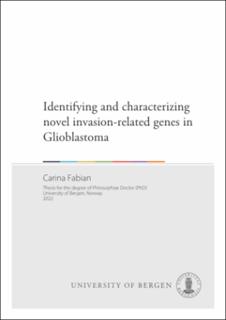| dc.contributor.author | Fabian, Carina | |
| dc.date.accessioned | 2022-03-14T11:49:50Z | |
| dc.date.available | 2022-03-14T11:49:50Z | |
| dc.date.issued | 2022-03-25 | |
| dc.date.submitted | 2022-03-07T12:29:55.066Z | |
| dc.identifier | container/f9/35/0f/5b/f9350f5b-0e77-47b4-b523-10a4f5c477e8 | |
| dc.identifier.isbn | 9788230855010 | |
| dc.identifier.isbn | 9788230842430 | |
| dc.identifier.uri | https://hdl.handle.net/11250/2985060 | |
| dc.description.abstract | Glioblastoma (GBM) represents the most devastating brain tumor in adults. Its characteristic ability to extensively invade into healthy brain structures forms a major challenge in regard to treatment as these diffusely invading cells evade local and systemic therapy. GBM invasion therefore represents a leading cause for therapy resistance and tumour recurrence, resulting in a dismal prognosis of around 15 months. This highlights the need to better understand the mechanisms underlying the invasive phenotype of GBM cells.
The following thesis is based on a previously performed short hairpin RNA (shRNA)interference screen that was utilized for the identification of novel invasion-promoting and invasion-inhibiting genes in GBM. This genome-wide shRNA interference screen was done in a highly invasive patient-derived GBM cell line using an in vitro Boyden chamber invasion assay and led to the identification of candidate genes potentially involved in GBM invasion.
Following bioinformatic analyses, various candidate genes of interest were identified, from which some were selected for further investigation. One of the top hits from the invasion-promoting gene list was the AN1-type zinc finger protein 3 (ZFAND3), which we were able to identify as a novel driver of GBM cell invasion through the transcriptional regulation of invasion-related genes. We showed that a knockdown of ZFAND3 reduced in vitro, ex vivo and in vivo invasion of invasive GBM cells, whereas its overexpression enhanced the invasion capacity of initially non-invasive GBM cells. We further determined that this activity required ZFAND3 nuclear localization and its two integral zinc finger domains.
Proteomic analyses revealed a range of proteasomal subunits and ubiquitin-associated proteins as potential interaction partners of ZFAND3, suggesting an involvement in proteasomal protein degradation. This hypothesis was strengthened by the cytoplasmic localization of ZFAND3 and by the fact that several other ZFAND proteins (ZFAND1, ZFAND2A, ZFAND2B, ZFAND5 and ZFAND6) were already shown to be implicated in the ubiquitin/proteasome system (UPS) and stress response signalling. Indeed, we found that ZFAND3 directly interacts with ubiquitin and with the ATP-selective ATPase valosin containing protein (VCP, also known as p97). Furthermore we found that ZFAND3 is involved in the clearance of sodium arsenite-induced stress granules.
Additional candidate genes that were selected for further investigation includedglutathione peroxidase 7 (GPX7) as potential invasion-promoting candidate gene, andglycerol kinase (GK), the general transcription factor IIH subunit 1 (GTF2H1) and the actin-related protein 1A (ACTR1A) as putative invasion-inhibiting candidate genes. We show that the knockdown of GPX7 reduced the in vitro and ex vivo invasion potential of invasive GBM cells, while its overexpression enhances the invasive capacity of initially non-invasive GBM cells. Overexpression of GK, GTF2H1 or ACTR1A led to decreased invasion in vitro and partially ex vivo.
In conclusion, these results highlight the relevance of the shRNA interference screen as a powerful tool to identify novel drivers and inhibitors involved in the invasive process of GBM cells. In addition, we also started to unravel the cytoplasmic function of ZFAND3, which includes its potential involvement in the UPS and in the clearance
of stress granules. | en_US |
| dc.language.iso | eng | en_US |
| dc.publisher | The University of Bergen | en_US |
| dc.relation.haspart | Paper I. AN1-type zinc finger protein 3 (ZFAND3) is a transcriptional regulator that drives Glioblastoma invasion. Schuster A, Klein E, Neirinckx V, Knudsen AM, Fabian C, Hau A-C, Dieterle M, Oudin A, Nazarov PV, Golebiewska A, Muller A, Perez-Hernandez D, Rodius S, Dittmar G, Bjerkvig R, Herold-Mende C, Klink B, Kristensen BW, Niclou SP. Nat Commun. 2020 Dec 11; 11(1): 6366. The article is available at: <a href="https://hdl.handle.net/11250/2759977" target="blank">https://hdl.handle.net/11250/2759977</a> | en_US |
| dc.relation.haspart | Paper II. The role of ZFAND3 in proteasomal degradation. Fabian C, Eiden K, Dieterle M, Klein E, Fritah S, Perez Hernandez D, Niclou SP. Not available in BORA | en_US |
| dc.relation.haspart | Paper III. Large scale shRNA interference screen to unravel Glioblastoma invasion.Fabian C, Nazarov PV, Schuster A, Sarnow K, Kanli G, Golebiewska A, Bjerkvig R, Niclou SP. Not available in BORA | en_US |
| dc.rights | In copyright | |
| dc.rights.uri | http://rightsstatements.org/page/InC/1.0/ | |
| dc.title | Identifying and characterizing novel invasion-related genes in Glioblastoma | en_US |
| dc.type | Doctoral thesis | en_US |
| dc.date.updated | 2022-03-07T12:29:55.066Z | |
| dc.rights.holder | Copyright the Author. All rights reserved | en_US |
| dc.contributor.orcid | https://orcid.org/0000-0002-2721-3052 | |
| dc.description.degree | Doktorgradsavhandling | |
| fs.unitcode | 13-14-0 | |
